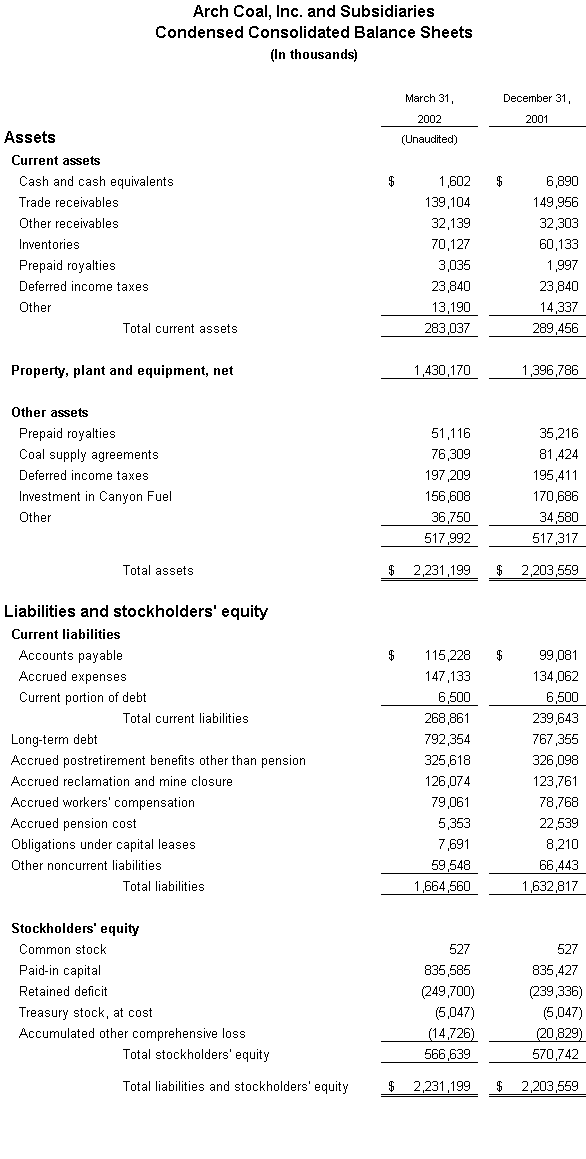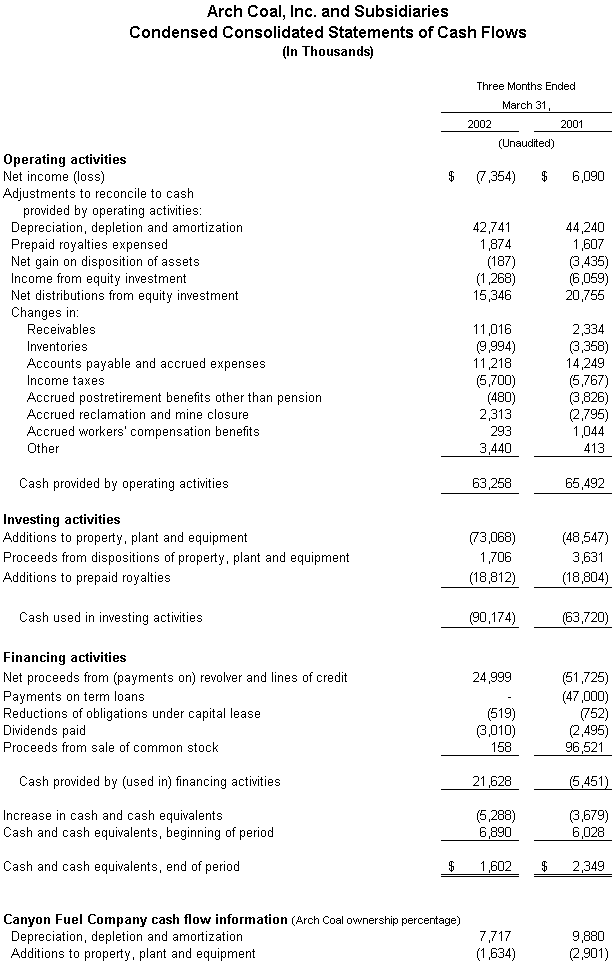Arch Coal, Inc. Reports First Quarter Results
Arch Coal, Inc. Reports First Quarter Results
April 22, 2002 at 10:21 AM EDT
Highlights:
- Net loss of $7.4 million, or $.14 per share, vs. net income of $6.1 million, or $.15 per share, in 1Q01
- Adjusted EBITDA of $49.1 million, vs. $80.3 million in 1Q01
- Total revenues of $368.5 million, vs. $381.4 million in 1Q01
- Coal sales of 24.7 million tons, vs. 27.2 million tons in 1Q01
St. Louis – April 22, 2002 - Arch Coal, Inc. (NYSE:ACI) today announced that it had a net loss of $7.4 million, or $.14 per share, for its first quarter ended March 31, 2002. The company had previously announced that it expected a net loss of between $.05 and $.15 for the quarter. In the same quarter of 2001, Arch had net income of $6.1 million, or $.15 per share.
U.S. coal markets are currently in a state of oversupply following an extremely mild winter and a period of economic weakness that dampened electricity demand in recent quarters. In response to this unfavorable near-term spot market environment, Arch announced in March that it had reduced the rate of production at its mining operations by approximately 7%. At the same time, the company announced that it would cut 2002 capital spending from its previous estimate of between $180 million and $200 million, to an expected $150 million.
“The single biggest influence on the quarter’s performance was our decision to curtail production at our mines in response to the weak market environment,” Leer said. “As a market-driven company, we don’t believe it is wise to force tonnage into an oversupplied market. These actions increase our per-ton costs in the short term, but should have a significant long-term benefit.”
“We continue to take steps to align our costs with reduced production levels, and we expect this effort to lead to an improved performance in the year’s second half and thereafter,” Leer added. “However, most of our costs are relatively fixed in the near term – and the fact that those costs are now being spread over fewer tons will have a continuing impact on our operating results as we enter the second quarter. Nevertheless, we are confident that we are doing the right thing for the company, its shareholders and its employees by electing not to sell coal into the spot market at very low prices.”
Market environment
Stockpile levels at power producers remain high, and, in keeping with its market-driven philosophy, Arch has tried to work with its customers to address that issue. However, Leer noted that there is good reason for optimism in the intermediate and longer term. “Industrial activity appears to be picking up, natural gas prices have climbed higher on the expectation of more robust demand, and coal prices – especially for coal to be delivered in future periods – are showing signs of a rebound,” Leer said. “If normal weather patterns return – and I might note that we have seen an early start to the air-conditioning season – we expect the market to continue to strengthen as we move into summer.”
Leer pointed out that the company should be in a strong position to respond as a stronger market environment materializes. “The steps that we have taken to curtail production will enhance our ability to provide low-cost coal to the market as electricity demand rebounds, and should serve the company well as it makes commitment for future periods,” he said.
Leer reiterated that the decision to curtail production instead of participating in the spot market would continue to have an adverse impact on revenues and margins in the near term, and indicated that the company currently expects a loss of between $.04 and $.12 in the second quarter absent a change in the current market environment. “With continued cost control efforts and the prospects of a stronger demand and pricing environment, we are optimistic that the company will have a much stronger second half,” Leer said. “We believe that the operational challenges at two of our mines, West Elk and Samples, are behind us, and we are well positioned to capitalize when coal markets strengthen.”
Other developments
Arch Coal and its Arch Western Resources subsidiary completed the refinancing of their existing credit facilities on April 18. The new credit facilities include five- and six-year term loans totaling $675 million at Arch Western Resources, and a five-year revolver totaling $350 million for Arch Coal. Arch expects its blended cost of debt to be generally consistent with the level of past years.
The company also announced on April 19 that it had created a limited partnership, Natural Resource Partners L.P., with three affiliated private companies – Western Pocahontas Properties Limited Partnership, Great Northern Properties Limited Partnership and New Gauley Coal Corporation (collectively, the “WPP Group”). Natural Resource Partners was formed to engage principally in the business of owning and managing coal royalty properties in the three major coal-producing regions of the United States: Appalachia, the Illinois Basin and the Western United States. The partnership has filed a registration statement on Form S-1 with the Securities and Exchange Commission relating to a proposed underwritten initial public offering of common units representing limited partner interests in Natural Resource Partners. Arch is contributing approximately 454 million tons of its 3.4 billion tons of total reserves to Natural Resource Partners.
Operating statistics
Regional analysis: Of the 24.7 million tons of coal that Arch sold during the first quarter, approximately 8.1 million tons originated at its eastern operations and 16.6 million tons originated at its western operations. Arch Coal had an average realized sales price of $14.53 per ton and average operating costs of $14.07 per ton. The eastern operations had an average realized sales price of $30.39 per ton and an average cost of $29.30 per ton during the quarter. The western operations had an average realized sales price of $6.73 per ton and an average cost of $6.53 per ton during the quarter. (Western operations data does not include the results of 65%-owned Canyon Fuel Company, which is accounted for on the equity method.)
Expected sales volume for the second quarter of 2002: In the east, Arch expects to sell a total of approximately 7.2 million tons of coal in the second quarter from its mines in Central Appalachia, excluding brokered tons. In the west, Arch expects to sell approximately 15.0 million tons of coal at its Black Thunder mine in the Powder River Basin of Wyoming, and roughly 1.7 million tons at the West Elk mine in Colorado, excluding brokered tons. Total sales (on a 100% basis) at Arch’s 65%-owned Canyon Fuel operations in Utah are expected to exceed 3.0 million tons for the second quarter.
Financial: Arch expects depreciation, depletion and amortization to total approximately $210 million in 2002, which is lower than previously expected due to downward revisions in anticipated capital spending. Capital expenditures are expected to total approximately $150 million. (Projections for depreciation, depletion and amortization and capital expenditures include Arch’s ownership percentage in Canyon Fuel Company.)
Looking ahead
“We are very optimistic about the future,” Leer said. “We believe we have successfully addressed operating challenges that adversely affected the recent performances of two of our mines, and we are well-positioned to respond to an improving demand and price environment as we look beyond the current shoulder season.”
Leer added that the long-term outlook for coal looks bright. “The driving forces that spurred last year’s strong demand and pricing environment are still very much in place,” Leer said. “Nuclear power plants are unlikely to improve on their record performances of recent years. High natural gas prices in the face of a strong storage picture suggest concerns about supply going forward. And an increasingly tense geopolitical environment may lead to a greater emphasis on domestic energy sources such as coal. We firmly believe that coal is the only economic option available for fueling the nation’s ever-increasing demand for baseload electric power over the course of the next decade.”
A conference call concerning first quarter earnings will be webcast live today at 11 a.m. EDT. The conference call can be accessed via the “investor” section of the Arch Coal web site (www.archcoal.com).
Arch Coal is the nation’s second largest coal producer with subsidiary operations in West Virginia, Kentucky, Virginia, Wyoming, Colorado and Utah. Through these operations, Arch Coal provides the fuel for approximately 6% of the electricity generated in the United States.
Definition: Adjusted EBITDA is presented above because it is a widely accepted financial indicator of a company’s ability to incur and service debt. Adjusted EBITDA should not be considered in isolation or as an alternative to net income, operating income, cash flows from operations, or as a measure of a company’s profitability, liquidity or performance under generally accepted accounting principles. Adjusted EBITDA is defined as income from operations before the effect of net interest expense, income taxes, and depreciation, depletion and amortization for Arch Coal, Inc., its subsidiaries and its ownership percentage in its equity investments.
Forward-Looking Statements: Statements in this press release which are not statements of historical fact are forward-looking statements within the “safe harbor” provision of the Private Securities Litigation Reform Act of 1995. These forward-looking statements are based on information currently available to, and expectations and assumptions deemed reasonable by, the company. Because these forward-looking statements are subject to various risks and uncertainties, actual results may differ materially from those projected in the statements. These expectations, assumptions and uncertainties include: the company’s expectation of continued growth in the demand for electricity; belief that legislation and regulations relating to the Clean Air Act and the relatively higher costs of competing fuels will increase demand for its compliance and low-sulfur coal; expectation of improved market conditions for the price of coal; expectation that the company will continue to have adequate liquidity from its cash flow from operations, together with available borrowings under its credit facilities, to finance the company’s working capital needs; a variety of operational, geologic, permitting, labor and weather related factors; and the other risks and uncertainties which are described from time to time in the company’s reports filed with the Securities and Exchange Commission.


